The launch of ChatGPT has sparked hot debates worldwide about how AI is reshaping education.
Some people argue that generative AI is destroying young minds by giving students no chance to learn through trial and error. Instead, they rely on quick, simple solutions generated by smart machines with just a click.
In reality, all technologies carry risks when misused. Artificial intelligence is no different.
If used mindfully, AI becomes a true buddy for students and teachers by helping with quick planning, simplifying learning, and providing an extra boost when needed.
Edtech companies are already incorporating AI successfully, and the hunger for AI for education keeps getting stronger and will do so throughout the years.
The global AI EdTech market, valued at USD 3.65 billion in 2023, is expected to skyrocket to USD 92.09 billion by 2033, marking remarkable growth.
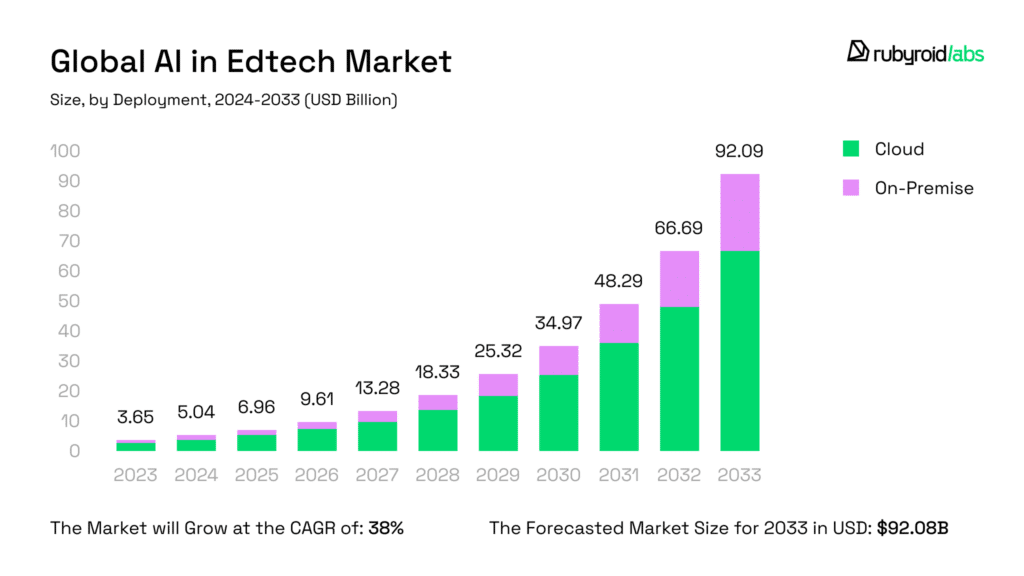
Source: market.us
That’s what we’ll discuss this time — how GenAI may supercharge education, create engaging experiences for every student, and take care of the boring paperwork.
If you are thinking about implementing AI into your e-learning platform or an app, we can consult, estimate, and develop AI-powered software according to your requirements. Our experience of AI integration spans online education, healthcare, insurance, sports, and more.
Contents
- AI in Education: A Benefit or a Risk?
- GenAI’s Role in Enhancing Personal Learning
- How AI tools Support Teaching and Assessment
- How AI Helps with Administrative Work
- The Future of AI in Education: What to Expect
- Wrapping Up
AI in Education: A Benefit or a Risk?
There’s no way back — AI has fundamentally reshaped how students tackle learning. Trying to stop them from using AI tools would be like trying to keep teenagers off social media – it’s simply unrealistic.
Fresh data from the Digital Education Council’s 2024 Global AI Student Survey confirms: students are fully embracing the power of AI. Let’s explore the most fascinating insights from the survey.
- More than 86% of students rely on artificial intelligence to help with their studies, with half using it on a daily or weekly basis.
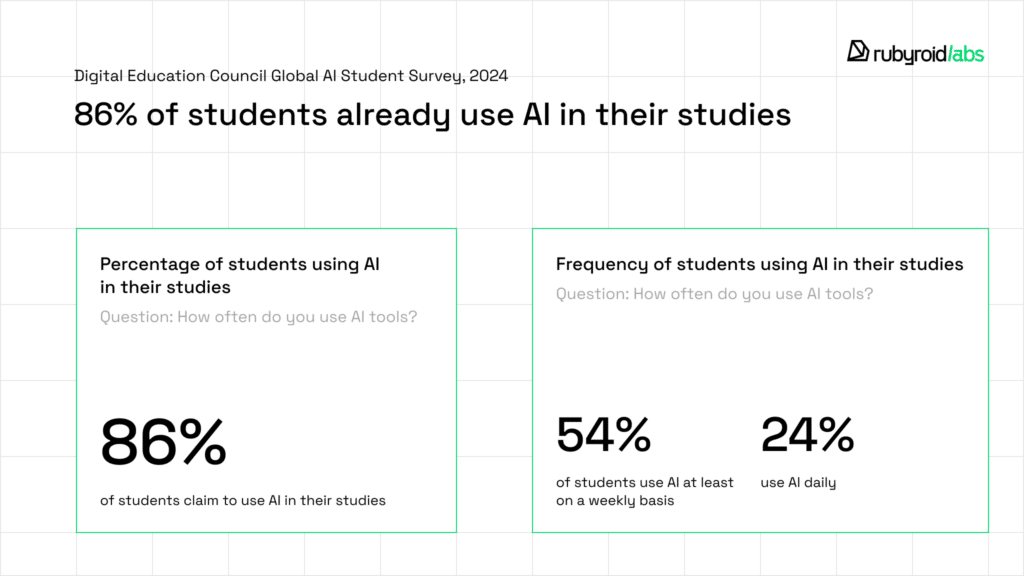
- When it comes to AI tools for education, students have their clear favorites: ChatGPT stands for versatile help; Copilot supports coding; Grammarly is in charge of better writing; Google Gemini provides various insights; and Perplexity helps with research.
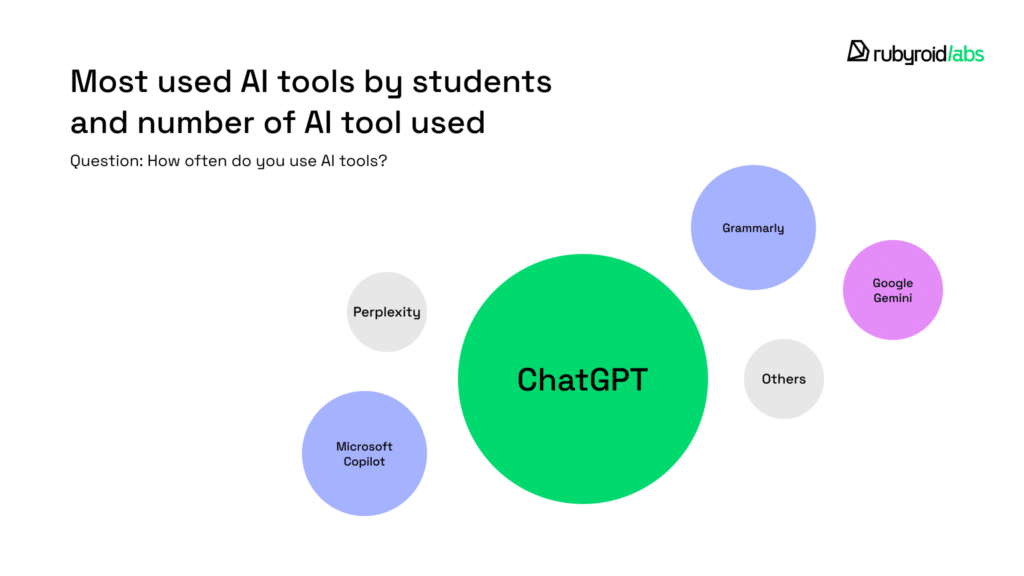
- Students have turned GenAI into their academic multitool, using it for better draft generation, clearer rephrasing, polished writing, and smarter searches.
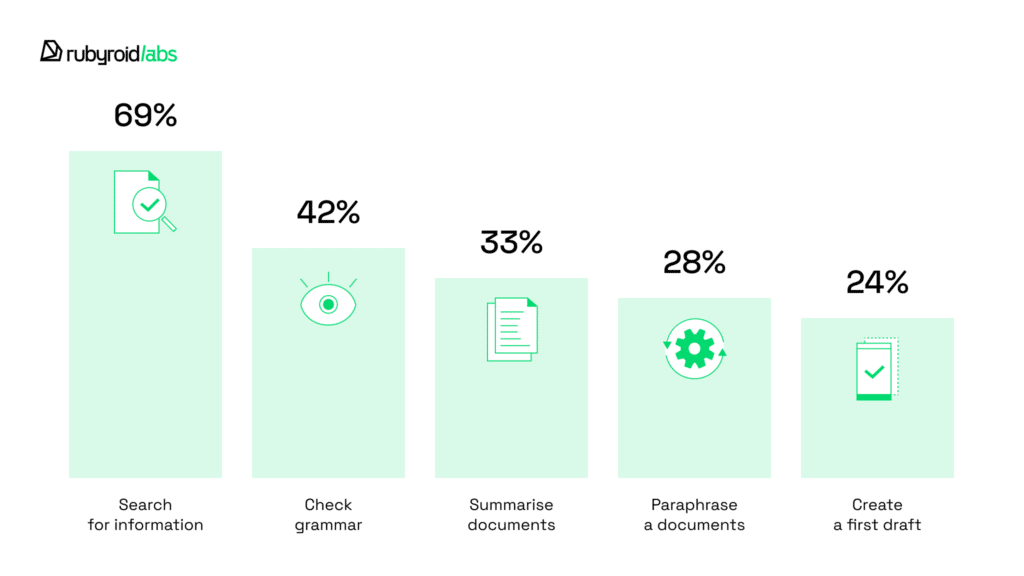
On closer look, students are turning to AI tools as to smart studdy-buddy that never sleeps, explains tough topics, and can always help.
Another intriguing study, published by the International Journal of Contemporary Issues in Social Sciences in June 2024, revealed surprising results regarding students’ dedication to their studies, their learning progress, and their frequency of using AI-powered study tools.
The research involved 500 students from five different universities, split into two age groups: 18-25 and 26-30. The findings showed a high level of student engagement, with an average score of 4.20 out of 5.00 when using AI for education. Apart from that, the learning outcome score averaged 4.35 out of 5.00, showing how AI learning companions are helping students unlock their full academic potential.
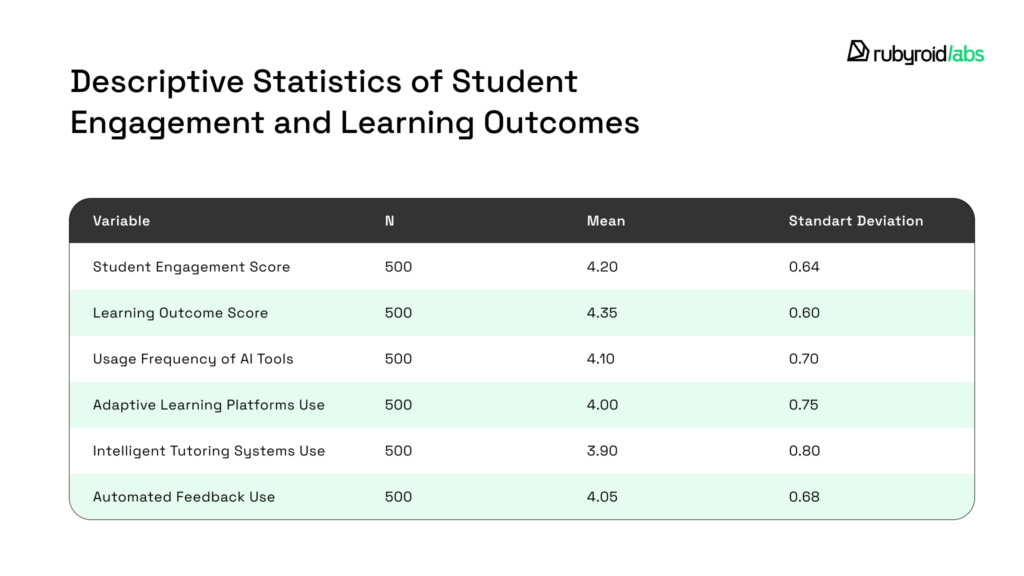
So, instead of viewing AI as a threat to traditional education, its intelligent power can be channeled in the right direction. Can you think of a better mission?
Now let’s look at the facts by comparing traditional education and AI-driven education.
Traditional vs. AI-enhanced Education Comparison
| Aspect | Traditional Education | AI-Enhanced Education |
| Teaching Strategy | Standardized material for average student with little opportunity for simpler explanations | AI assistants speak students’ language, explain topics for anyone, and provide extra information on subject |
| Students Engagement | Students sometimes learn passively due to the lecture-based structure of the educational process | Students get engaged with AI tools by asking and receiving responses on the topic |
| Assessment | Regular tests and fixed exams | Dynamic assessments with quick feedback and adaptive tests |
| Learning Pace | Fixed schedule for everybody | Individual speed for each student |
| Resources | Limitations of textbooks and handouts that can become outdated | Diverse digital tools and updated learning materials |
| Teacher’s Tasks | Numerous tasks, including teaching, planning, grading, creating, and notificating | More time for creative teaching as routine tasks are automated |
| Accessibility | Delayed responses on assignments | Immediate performance insights at any time |
| Content | Standardized curriculum for all students | Individualized learning materials |
| Parent Updates | Scheduled meetings and reports | Real-time progress tracking |
Thus, artificial intelligence can boost three core spheres of education:
- Personal learning
- Teaching and assessment
- Administrative work
We’ll look at each of the spheres below.
GenAI’s Role in Enhancing Personal Learning
The speed at which people understand and respond to new information varies depending on their unique abilities.
Some people pick up new material quickly and can apply it right away, while others might need extra time or more detailed explanations to fully grasp the topic. So, those students who learn at a different pace need a more individualized approach.
Here is where AI becomes a learning companion.
Like a personal tutor, it tracks progress, pinpoints challenges, and creates a personal learning path for getting better results. So, learning shifts from a tedious task to an engaging journey.
How AI Makes Learning Individual
AI collects information about a student from different sources for creating individual profiles. The system analyzes test scores and grades, examines learning patterns, and considers even emotional responses. With such comprehensive view, the student can understand:
- Whether they learn best visually, through audio, or by hands-on practice.
- Spot the points where students shine and where they need a boost.
- Shape content that speaks to their interests and ambitions.
AI turns basic lessons into learning experiences that click with each student.
Examples of Applying AI in E-Learning Apps for Personal Study
Grammarly: How to Write Brilliantly
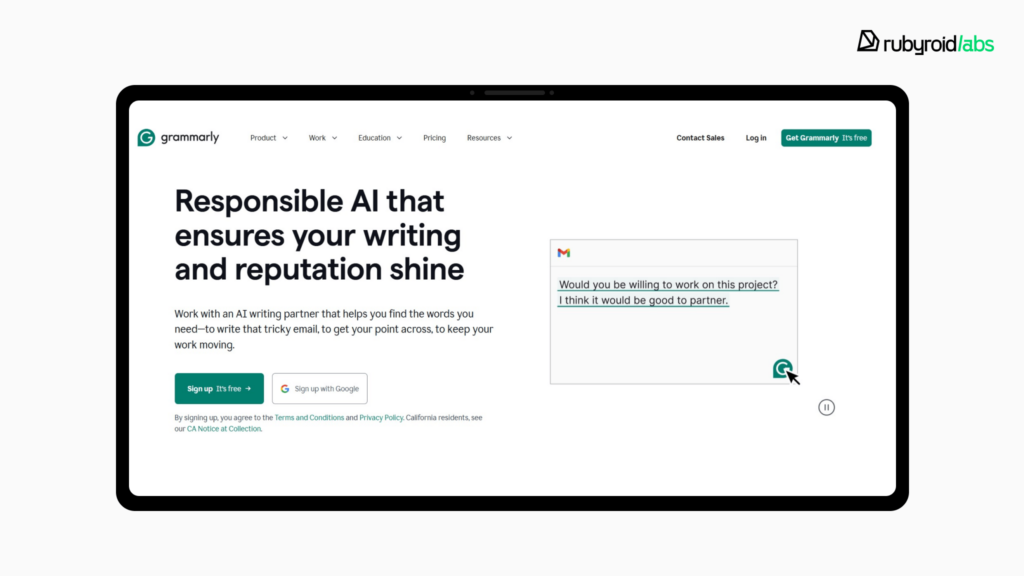
What it does: While mostly a writing assistant, Grammarly’s AI reads between your lines, fine-tuning grammar, style, and tone to match the voice.
How it helps: Acting as a grammar coach, the AI assistant scans the user’s writing style inside out and offers changes for better thought expression and correcting mistakes.
Duolingo: Playing While Learning
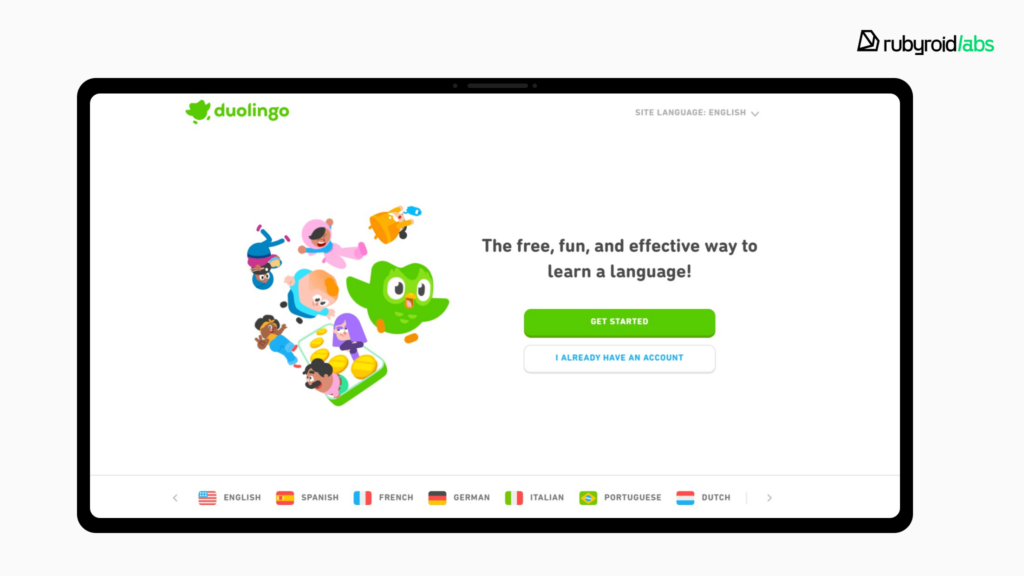
What it does: Behind every lesson of Duolingo there’s an AI brain that knows the user’s learning story, spots the gaps, and crafts topics accordingly.
How it helps: Duolingo modifies the difficulty of exercises on the spot, balancing challenge and comfort to keep the user in the learning zone.
Magoosh: Test Preparation Platform
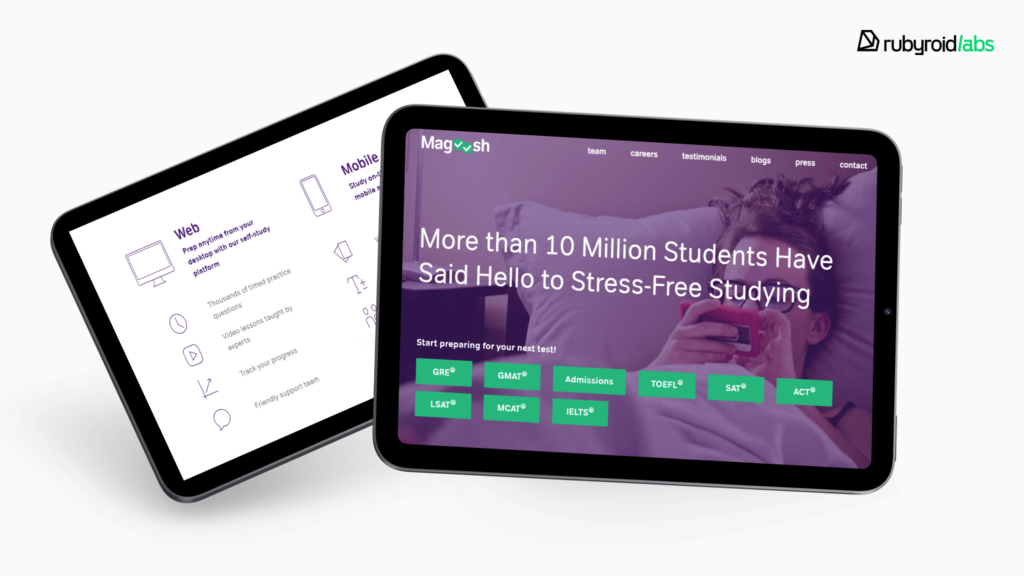
What it does: Magoosh is an online learning platform that tailors individual paths to international certifications, mastering TOEFL, GRE, LSAT, IELTS, and beyond.
How it helps: The platform handles over 10 million users and provides practice materials for self-learning.
The client intended to expand their business by cooperating with academic organizations. In addition to new features, our team built a B2B dashboard that tracks how students learn and succeed across completed modules.
Also, the project owner requested a UI/UX design review of their checkout page to boost conversion of users into customers. After the analysis, we provided our solution that included check-out page optimization, visual hierarchy improvements, and order preview creation.
Another part of our work was plugging in the Schoology learning management system to the app. This allowed us to create a smooth flow for managing courses, sharing materials, and connecting teachers with students.
The client achieved higher user interaction levels, grew their sales pipeline, and rewarded our work with a 5-star Clutch review.
You can develop your own app or platform and strengthen it with a chatbot based on an integrated API from OpenAI, Claude, or Google Gemini. Our AI developers are ready to consult with you on your solution. Check out the full list of services we offer, along with the integrations we provide, on our ChatGPT integration service page.
How AI Tools Support Teaching and Assessment
Modern teaching isn’t just about explaining topics in class or online — it also comes with a lot of extra work, like creating lesson plans, organizing activities, and keeping everything running smoothly.
Grading takes a large part of teaching, and yet it is difficult. Teachers frequently struggle to stay neutral, as factors like mood, personal preferences, and exhaustion can all impact the evaluation process. Even unintentionally, these factors may result in unequal or unfair assessments that benefit neither teachers nor students.
GenAI lowers teacher workloads by managing assessments and monitoring student progress. Let’s dive into the specifics.
Scenarios for Using AI in Teaching and Testing
AI helps teachers with routine handwork thanks to smart task automation:
- Creates personalized lesson paths based on student performance.
- Searches and advises extra materials for diving into the subject deeper, either for groups or for individuals.
- Tracks learning journeys and delivers insight-rich reports.
- Takes on written assessment workload, which significantly reduces the time teachers spend on grading.
- Automates test grading.
AI-powered Examples for Teaching and Assessment
Gradescope: Stress-Free Grading
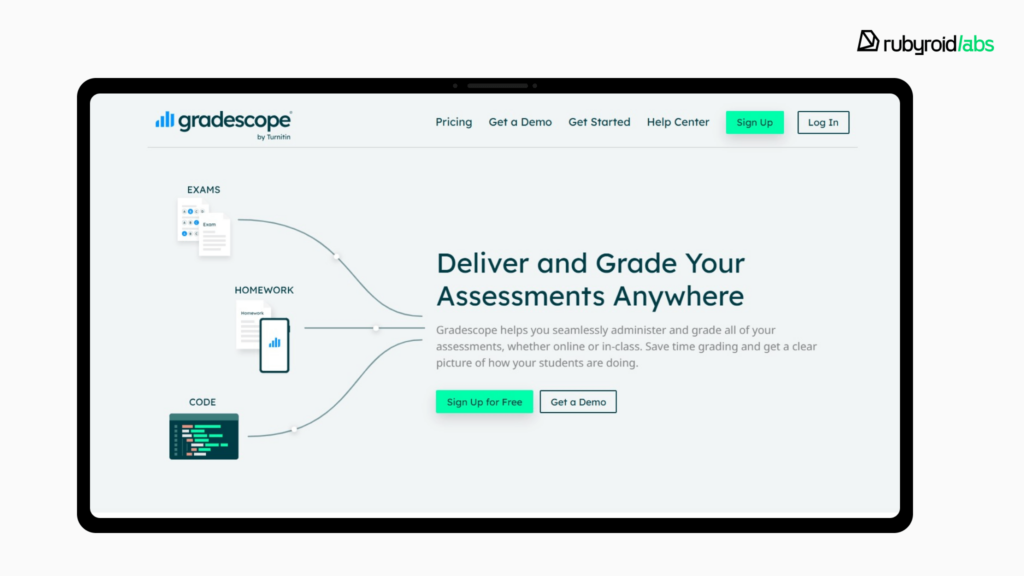
What It Does: With its AI engine, Gradescope takes care of grading tasks from multiple-choice quizzes to complex code assignments.
How It Helps: Each submission gets fair, detailed feedback, freeing teachers from hours of manual grading.
Knewton Alta: AI-based Learning Navigator
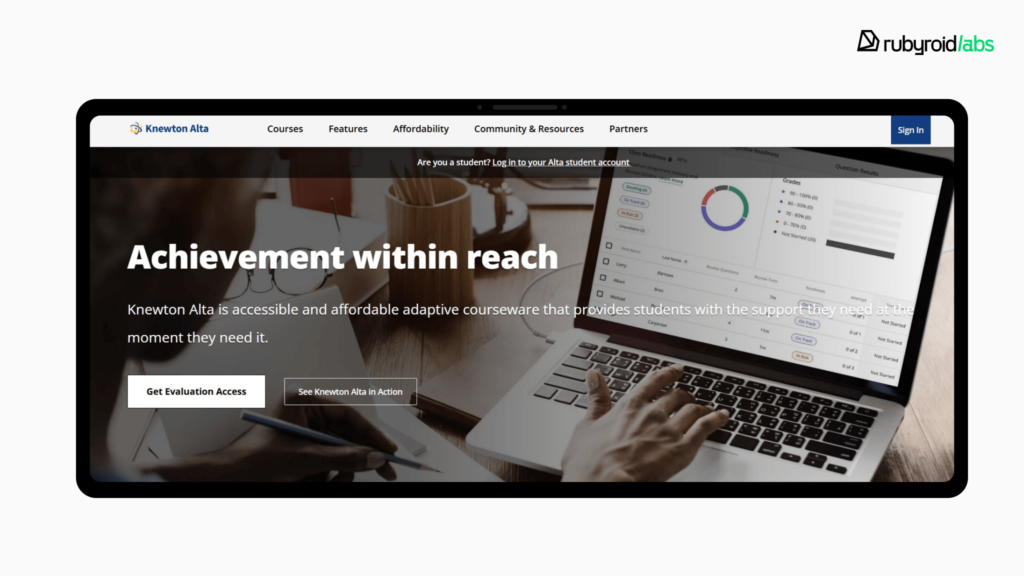
What It Does: Knewton Alta tracks student performance and uses AI to recommend personalized lesson materials that address individual learning gaps.
How It Helps: By pinpointing exactly where each student struggles, it helps them grow in their knowledge.
How AI Helps with Administrative Work
Teachers spend numerous hours battling with administrative tasks, such as emailing, scheduling, resource sorting, and classroom organization. The flood of responsibilities frequently drowns out their real job of assisting young minds and starting study adventures.
Many of these time-consuming processes can be automated using artificial intelligence. By reducing manual effort, AI enables teachers to reclaim their time and energy, making their work more efficient and their teaching more effective. Let’s examine some key use cases of AI in automating administrative tasks.
AI Use Cases in Automating Administrative Tasks
Any AI model can be trained to carry out different tasks. Integrating AI into an app can simplify teachers’ lives in the following ways:
- Handle operational classroom activities, like tracking attendance and sending reminders.
- Simplify scheduling by automatically creating class timetables, organizing meetings, and setting up parent-teacher conferences.
- Automate routine communication: reminders for deadlines, meeting invitations, or updates for parents.
- Create progress reports for each student that show their strengths, areas they can work on, and overall performance.
Examples of AI-based Platforms for Administrative Tasks
PowerSchool: Administrative Engine
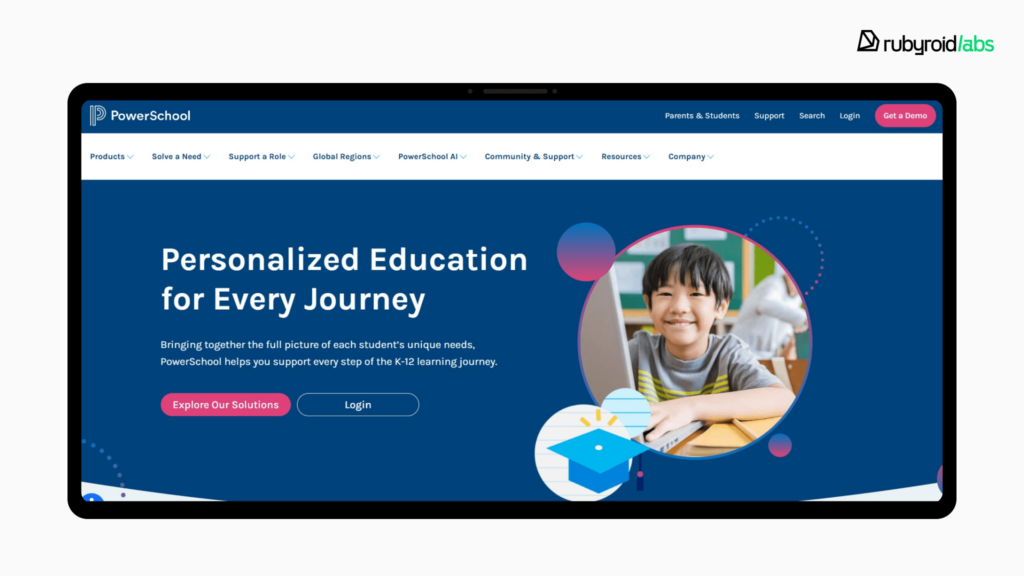
What It Does: PowerSchool transforms administrative chaos into harmony, weaving attendance, grades, and parent communication into one seamless system.
How It Helps: The AI-powered program generates progress reports, automates attendance tracking, and keeps parents informed, reducing teachers’ time spent on manual data entry and follow-ups.
ClassDojo: Teaching Assistant
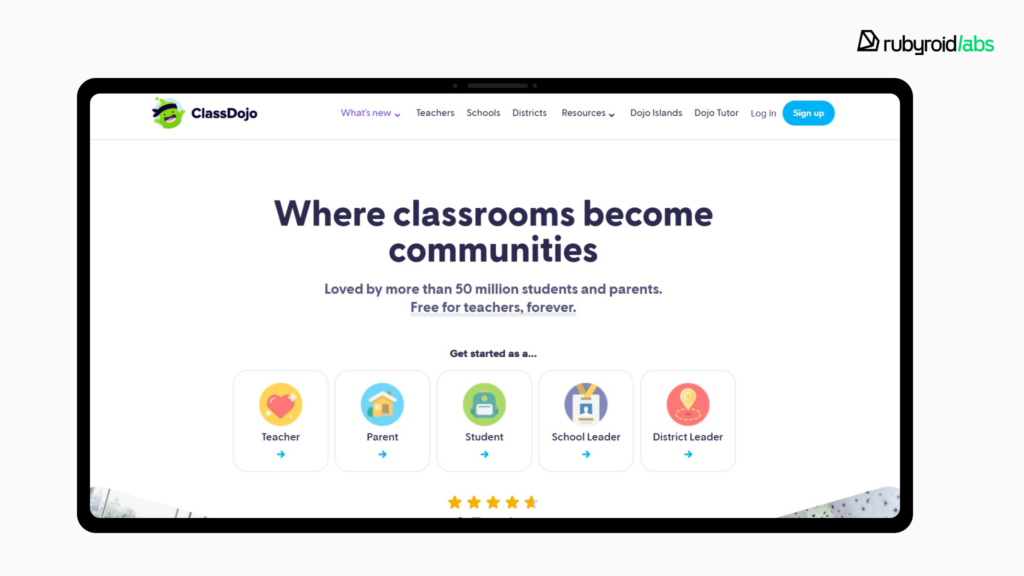
What It Does: ClassDojo serves as a classroom copilot, overseeing everyday operations while keeping parents informed.
How It Helps: It streamlines student participation tracking, attendance monitoring, and parent communication, allowing teachers to focus more on teaching and less on administrative tasks.
The Future of AI in Education: What to Expect?
It’s obvious we’re witnessing just the opening chapter of AI in education.
As AI-powered digital tools improve their intelligence and intuitiveness, they will become ever more effective allies for both students and teachers.
The Forbes Advisor survey highlights that organizations such as the US Department of Education and UNESCO recommend the development of AI tools that work with teachers, not against them. Their goal is to create systems that support educators’ traditional roles rather than replace them with flashy tech.
One of the interesting points here is that even though many teachers see the value of using AI-powered platforms in education, they don’t think the smart tools will play a central role in conducting lessons. Instead, they see it as a sidekick—something to make their jobs easier, not a replacement.
Most educators also expressed the need to teach students how to use AI responsibly. With so many students using AI to cheat on assignments, it’s clear that ethical education around AI is becoming a priority.
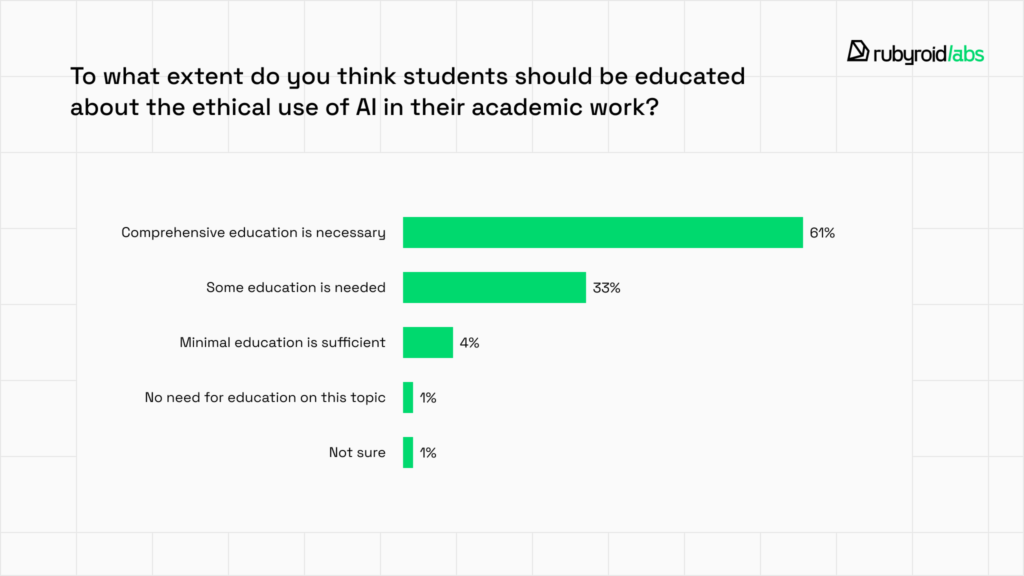
What’s Coming Next?
The potential for artificial intelligence in education is truly inspiring—especially if it’s applied responsibly. Here’s what the future might hold:
Personal approach for everyone
AI is already customizing lessons and learning materials to fit the unique needs of individual students. This trend is only expected to grow as adaptive learning solutions continue to show their effectiveness. Teachers also stand to gain, with AI tools simplifying tasks like lesson planning, grading, and monitoring student progress.
More intelligent AI assistants
In the near future, they’ll be able to support students and educators even further by simplifying complex topics, analyzing data, and helping manage schedules more efficiently.
Interactive learning with VR and AR
Pairing AI with virtual reality (VR) and augmented reality (AR) will make learning way more engaging. Imagine medical students practicing surgery in a virtualized operating room, engineers testing designs in a digital space, or young architects walking through their designs before they’re built.
Inclusive education for all
AI can make education more accessible to everyone, including people with limitations and those from underprivileged regions. The key features, such as real-time translation, text-to-speech, and adaptive learning, can give a chance to students with learning disabilities or language challenges to obtain excellent education. AI adapts to each student’s unique needs, no matter their circumstances or challenges.
Wrapping Up
The future has come. Little by little, traditional education is merging with artificial intelligence, reshaping how we think about learning and teaching.
Developing an AI-supported learning app isn’t just a smart business decision—it’s a meaningful mission and a precious investment in shaping the education of tomorrow.
At Rubyroid Labs, we’re here to guide you in deciding the best AI technology, crafting a user-friendly interface, and assembling a skilled team of developers to make your vision a reality.
Get in touch with us, and we’ll provide a project estimate tailored to your needs—whether you’re looking to build:
- A personalized learning platform
- An AI-powered learning game
- An automated grading and feedback tool
- A smart tutoring system
- A student support chatbot
But our work doesn’t stop at education. Since people can trust AI, our company has helped other industries advance. We share insights about these projects in our blog posts:
- AI in Sports: How GenAI Chatbot Integration Empowers the Industry
- Fleeting Trend or the Future: AI in the Insurance Industry
Ready to make your mark on the future of education—or beyond? Let’s talk and bring your ideas to life!



